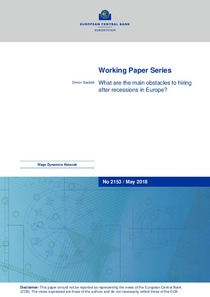What are the main obstacles to hiring after recessions in Europe?
"This paper assesses the relative importance of perceived obstacles to hiring workers on a permanent basis faced by EU firms and studies how they depend on firm’s characteristics. Findings suggest that the main obstacles to hiring in Europe are high uncertainty, shortage of skilled labour, high...
| Main Author: | |
|---|---|
| Institution: | ETUI-European Trade Union Institute |
| Format: | TEXT |
| Language: | English |
| Published: |
Frankfurt am Main
2018
ECB |
| Subjects: | |
| Online Access: | https://www.labourline.org/KENTIKA-19302914124911201969-What-are-the-main-obstacles-to.htm |
| Summary: | "This paper assesses the relative importance of perceived obstacles to hiring workers on a permanent basis faced by EU firms and studies how they depend on firm’s characteristics. Findings suggest that the main obstacles to hiring in Europe are high uncertainty, shortage of skilled labour, high payroll taxes, high wages and the risks associated with changes to labour laws. While negative (firm-level) demand and finance shocks negatively affect firms’ perceptions of obstacles to hiring, labour market structures and firms’/employees’ characteristics are also found significant. In particular, our analysis shows that firms employing a higher percentage of skilled, permanent and experienced workers report fewer hiring obstacles. In contrast, firms under collective wage bargaining arrangements seem to report these obstacles more often. However, there are also some specific obstacles to hiring where this is not the case, which suggests that firm-level characteristics should also be taken into account when designing labour market policies. Finally, our analysis provides further tentative evidence on the impacts of labour market reforms, which seem to have a potential to address impediments towards employment creation in the EU." |
|---|---|
| Physical Description: | 24 p. Digital |

